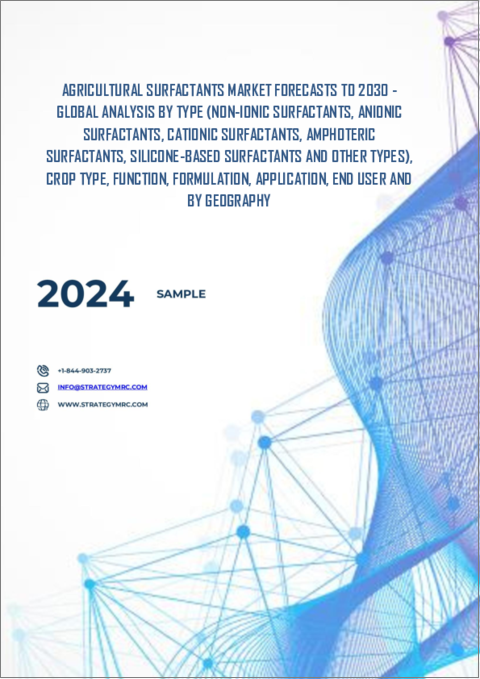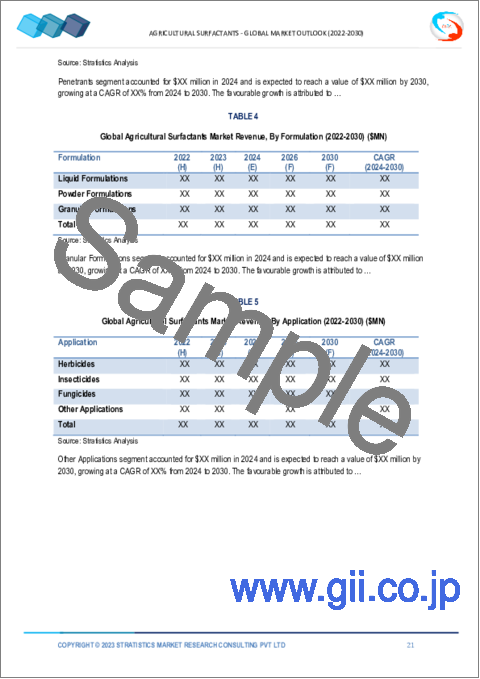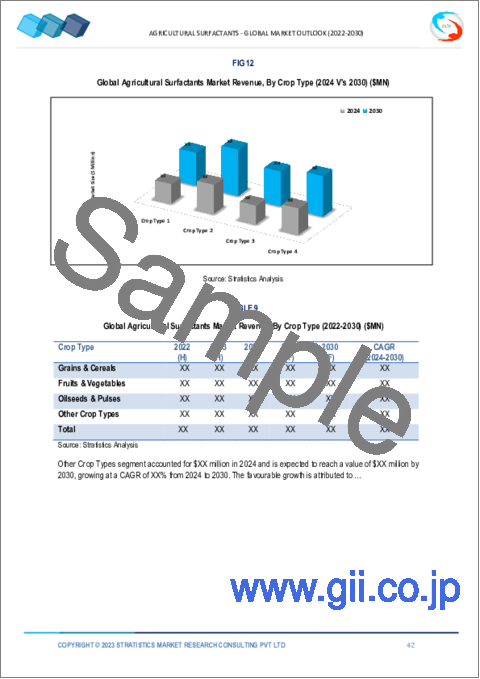|
|
市場調査レポート
商品コード
1503413
農業用界面活性剤市場の2030年までの予測: タイプ別、作物タイプ別、機能別、剤形別、用途別、エンドユーザー別、地域別の世界分析Agricultural Surfactants Market Forecasts to 2030 - Global Analysis By Type, Crop Type, Function, Formulation, Application, End User and By Geography |
||||||
カスタマイズ可能
|
|||||||
| 農業用界面活性剤市場の2030年までの予測: タイプ別、作物タイプ別、機能別、剤形別、用途別、エンドユーザー別、地域別の世界分析 |
|
出版日: 2024年06月06日
発行: Stratistics Market Research Consulting
ページ情報: 英文 200+ Pages
納期: 2~3営業日
|
全表示
- 概要
- 図表
- 目次
Stratistics MRCによると、世界の農業用界面活性剤市場は2024年に20億米ドルを占め、予測期間中にCAGR 6.9%で成長し、2030年には30億米ドルに達すると予測されています。
農業用界面活性剤は、殺虫剤、除草剤、殺菌剤、肥料の効果を高めるために農業で使用される化学添加剤です。界面活性剤は、液体の表面張力を低下させ、植物の表面により均一に広がり、土壌により効果的に浸透するようにします。界面活性剤は、農薬の浸透性、湿潤性、吸収性を向上させることで、農薬の有効性を高め、無駄を省きます。界面活性剤は、撥水性の土壌や蝋質の植物表面が、農薬の適切な分布や吸収を阻害している場合に特に有用です。
国連食糧農業機関(FAO)によると、2021年の穀物・穀類総生産量は28億1,900万トンだった。これは2020年に記録された総生産量から1.6%の増加です。
グリーン・ソリューションへの需要の高まり
環境への関心が高まるにつれ、農業用界面活性剤市場でも環境に優しいソリューションへの需要が顕著に高まっています。農家や農業関連企業は、環境に優しく持続可能な界面活性剤を求めるようになっています。この動向は、消費者の嗜好と規制の圧力の両方によって、農業においてより環境に配慮した慣行への幅広いシフトを反映しています。各メーカーは、こうした基準を満たす界面活性剤を開発・販売することで、市場の進化するニーズに応えています。
遺伝子組み換え種子の使用
遺伝子組換え種子の使用は、潜在的な適合性の問題により、市場における課題となっています。これらの作物は、最適な性能を発揮するために特定の界面活性剤を必要とする場合があり、従来の界面活性剤はこれらの作物への使用に適さない場合があります。このため、作物品種に合わせた特殊な界面活性剤の開発が必要となり、界面活性剤メーカーの研究開発コストが増加する可能性があります。さらに、農作物の環境への影響に対する懸念が、消費者の嗜好や界面活性剤に対する需要に影響を与える可能性もあります。
農薬の効能向上の必要性
農薬の効き目を向上させることは、作物の保護と収量を向上させる市場において極めて重要です。界面活性剤は、植物表面への付着性、被覆性、浸透性を向上させることにより、農薬の有効性を高める上で重要な役割を果たしています。界面活性剤製剤の革新は、散布範囲の改善、流出の減少、有効成分の吸収の強化につながり、環境への影響を最小限に抑え、農業における資源利用を最適化しながら、より優れた害虫駆除と雑草管理を実現します。
ライバル製剤との競合
企業は自社製品の革新と差別化に努めているため、優れた性能、環境持続性、費用対効果を提供する製剤を開発しなければならないというプレッシャーに直面しています。競合製剤は、新しい有効成分、独自の技術、または改良された製剤を導入する可能性があり、企業は市場での競争力を維持するために研究開発に継続的に投資することが不可欠となります。さらに、規制の変更と顧客の嗜好の進化が、この分野の競争をさらに激化させています。
COVID-19の影響:
COVID-19の大流行は農業セクターの混乱を招き、農業に使用される界面活性剤の需要に影響を与えています。サプライチェーンの混乱、農業活動の減少、経済の不確実性が市場に影響を及ぼしています。しかし、農業生産性の向上における界面活性剤の重要性に対する認識は高まっており、業界が新たな規範に適応し、持続可能な実践に注力することで、長期的には潜在的な成長機会につながります。
陽イオン界面活性剤セグメントは予測期間中に最大となる見込み
カチオン界面活性剤は、殺虫剤と除草剤の効果を向上させる能力があるため、予測期間中に最大となる見込みです。カチオン界面活性剤は、表面張力を低下させ、植物表面における有効成分の被覆性と浸透性を向上させる。これは農薬の性能と効力の向上につながり、最終的には作物の保護と収量を向上させる。これらは、水質や土壌条件が従来の農薬散布方法に課題をもたらすような状況で特に効果的です。
温室事業者セグメントは予測期間中最も高いCAGRが見込まれる
温室事業者は、事業で使用する農薬、除草剤、肥料の効果を高めるためにこれらの製品に依存しているため、予測期間中のCAGRは温室事業者セグメントが最も高くなると予想されます。界面活性剤を散布ルーチンに組み込むことで、温室業者は農薬の適用範囲と吸収をより確実にし、作物の収量と植物全体の健康状態の改善につなげることができます。さらに、界面活性剤は流出や土壌浸食などの問題を軽減するのに役立ち、温室事業と環境にさらなる利益をもたらします。
最大のシェアを占める地域
北米は、農薬需要の増加と近代的農法の採用により、予測期間中最大の市場シェアを占めると予測されます。界面活性剤は、表面張力を低下させ、散布範囲を改善することにより、殺虫剤、除草剤、殺菌剤の効力を高める上で重要な役割を果たしています。この地域の良好な規制環境は、農業技術の進歩と相まって、市場の拡大をさらに促進すると予想されます。さらに、持続可能な農業に対する意識の高まりが、バイオベースの界面活性剤の需要を促進しています。
CAGRが最も高い地域:
人口の増加、食糧需要の増加、近代的な農法の採用、効率的な作物保護ソリューションの必要性など、いくつかの要因により、アジア太平洋地域は予測期間中に最も高いCAGRを維持すると予測されます。界面活性剤は、殺虫剤、除草剤、その他の農薬の効果を向上させることにより、農業において重要な役割を果たしています。この市場は、湿潤剤、分散剤、乳化剤、アジュバントなど、さまざまな農業用途に合わせた幅広い界面活性剤製品によって特徴付けられています。
無料のカスタマイズサービス:
本レポートをご購読のお客様には、以下の無料カスタマイズオプションのいずれかをご利用いただけます:
- 企業プロファイル
- 追加市場プレイヤーの包括的プロファイリング(3社まで)
- 主要企業のSWOT分析(3社まで)
- 地域セグメンテーション
- 顧客の関心に応じた主要国の市場推計・予測・CAGR(注:フィージビリティチェックによる)
- 競合ベンチマーキング
- 製品ポートフォリオ、地理的プレゼンス、戦略的提携に基づく主要企業のベンチマーキング
目次
第1章 エグゼクティブサマリー
第2章 序文
- 概要
- ステークホルダー
- 調査範囲
- 調査手法
- データマイニング
- データ分析
- データ検証
- 調査アプローチ
- 調査情報源
- 1次調査情報源
- 2次調査情報源
- 前提条件
第3章 市場動向分析
- 促進要因
- 抑制要因
- 機会
- 脅威
- 用途分析
- エンドユーザー分析
- 新興市場
- COVID-19の影響
第4章 ポーターのファイブフォース分析
- 供給企業の交渉力
- 買い手の交渉力
- 代替品の脅威
- 新規参入業者の脅威
- 競争企業間の敵対関係
第5章 世界の農業用界面活性剤市場:タイプ別
- 非イオン界面活性剤
- 陰イオン界面活性剤
- カチオン界面活性剤
- 両性界面活性剤
- シリコン系界面活性剤
- その他のタイプ
第6章 世界の農業用界面活性剤市場:作物別
- 穀物
- 果物と野菜
- 油糧種子および豆類
- その他の作物
第7章 世界の農業用界面活性剤市場:機能別
- 湿潤剤
- 分散剤
- 乳化剤
- 浸透剤
第8章 世界の農業用界面活性剤市場:剤形別
- 液体製剤
- 粉末製剤
- 粒状製剤
第9章 世界の農業用界面活性剤市場:用途別
- 除草剤
- 殺虫剤
- 殺菌剤
- その他のアプリケーション
第10章 世界の農業用界面活性剤市場:エンドユーザー別
- 農業協同組合
- 農薬メーカー
- 研究機関
- 温室オペレーター
- 園芸
- その他のエンドユーザー
第11章 世界の農業用界面活性剤市場:地域別
- 北米
- 米国
- カナダ
- メキシコ
- 欧州
- ドイツ
- 英国
- イタリア
- フランス
- スペイン
- その他欧州
- アジア太平洋地域
- 日本
- 中国
- インド
- オーストラリア
- ニュージーランド
- 韓国
- その他アジア太平洋地域
- 南米
- アルゼンチン
- ブラジル
- チリ
- その他南米
- 中東・アフリカ
- サウジアラビア
- アラブ首長国連邦
- カタール
- 南アフリカ
- その他中東とアフリカ
第12章 主な発展
- 契約、パートナーシップ、コラボレーション、合弁事業
- 買収と合併
- 新製品発売
- 事業拡大
- その他の主要戦略
第13章 企業プロファイリング
- BASF SE
- Dow Chemical Company
- Croda International PLC
- Huntsman Corporation
- Evonik Industries AG
- Solvay S.A.
- Akzo Nobel N.V.
- Clariant AG
- Nufarm Limited
- Kao Corporation
- Mitsubishi Chemical Corporation
- Sumitomo Chemical Co., Ltd.
- Syngenta AG
- Novozymes A/S
- Lonza Group AG
- Corteva Agriscience
- Valent Biosciences Corporation
List of Tables
- Table 1 Global Agricultural Surfactants Market Outlook, By Region (2022-2030) ($MN)
- Table 2 Global Agricultural Surfactants Market Outlook, By Type (2022-2030) ($MN)
- Table 3 Global Agricultural Surfactants Market Outlook, By Non-Ionic Surfactants (2022-2030) ($MN)
- Table 4 Global Agricultural Surfactants Market Outlook, By Anionic Surfactants (2022-2030) ($MN)
- Table 5 Global Agricultural Surfactants Market Outlook, By Cationic Surfactants (2022-2030) ($MN)
- Table 6 Global Agricultural Surfactants Market Outlook, By Amphoteric Surfactants (2022-2030) ($MN)
- Table 7 Global Agricultural Surfactants Market Outlook, By Silicone-Based Surfactants (2022-2030) ($MN)
- Table 8 Global Agricultural Surfactants Market Outlook, By Other Types (2022-2030) ($MN)
- Table 9 Global Agricultural Surfactants Market Outlook, By Crop Type (2022-2030) ($MN)
- Table 10 Global Agricultural Surfactants Market Outlook, By Grains & Cereals (2022-2030) ($MN)
- Table 11 Global Agricultural Surfactants Market Outlook, By Fruits & Vegetables (2022-2030) ($MN)
- Table 12 Global Agricultural Surfactants Market Outlook, By Oilseeds & Pulses (2022-2030) ($MN)
- Table 13 Global Agricultural Surfactants Market Outlook, By Other Crop Types (2022-2030) ($MN)
- Table 14 Global Agricultural Surfactants Market Outlook, By Function (2022-2030) ($MN)
- Table 15 Global Agricultural Surfactants Market Outlook, By Wetting Agents (2022-2030) ($MN)
- Table 16 Global Agricultural Surfactants Market Outlook, By Dispersants (2022-2030) ($MN)
- Table 17 Global Agricultural Surfactants Market Outlook, By Emulsifiers (2022-2030) ($MN)
- Table 18 Global Agricultural Surfactants Market Outlook, By Penetrants (2022-2030) ($MN)
- Table 19 Global Agricultural Surfactants Market Outlook, By Formulation (2022-2030) ($MN)
- Table 20 Global Agricultural Surfactants Market Outlook, By Liquid Formulations (2022-2030) ($MN)
- Table 21 Global Agricultural Surfactants Market Outlook, By Powder Formulations (2022-2030) ($MN)
- Table 22 Global Agricultural Surfactants Market Outlook, By Granular Formulations (2022-2030) ($MN)
- Table 23 Global Agricultural Surfactants Market Outlook, By Application (2022-2030) ($MN)
- Table 24 Global Agricultural Surfactants Market Outlook, By Herbicides (2022-2030) ($MN)
- Table 25 Global Agricultural Surfactants Market Outlook, By Insecticides (2022-2030) ($MN)
- Table 26 Global Agricultural Surfactants Market Outlook, By Fungicides (2022-2030) ($MN)
- Table 27 Global Agricultural Surfactants Market Outlook, By Other Applications (2022-2030) ($MN)
- Table 28 Global Agricultural Surfactants Market Outlook, By End User (2022-2030) ($MN)
- Table 29 Global Agricultural Surfactants Market Outlook, By Agricultural Cooperatives (2022-2030) ($MN)
- Table 30 Global Agricultural Surfactants Market Outlook, By Agrochemical Manufacturers (2022-2030) ($MN)
- Table 31 Global Agricultural Surfactants Market Outlook, By Research Institutions (2022-2030) ($MN)
- Table 32 Global Agricultural Surfactants Market Outlook, By Greenhouse Operators (2022-2030) ($MN)
- Table 33 Global Agricultural Surfactants Market Outlook, By Horticulture (2022-2030) ($MN)
- Table 34 Global Agricultural Surfactants Market Outlook, By Other End Users (2022-2030) ($MN)
Note: Tables for North America, Europe, APAC, South America, and Middle East & Africa Regions are also represented in the same manner as above.
According to Stratistics MRC, the Global Agricultural Surfactants Market is accounted for $2.0 billion in 2024 and is expected to reach $3.0 billion by 2030 growing at a CAGR of 6.9% during the forecast period. Agricultural surfactants are chemical additives used in agriculture to enhance the effectiveness of pesticides, herbicides, fungicides, and fertilizers. They work by reducing the surface tension of liquids, allowing them to spread more evenly over plant surfaces and penetrate into the soil more effectively. Surfactants can help improve the coverage, wetting, and absorption of agricultural chemicals, thereby increasing their efficacy and reducing waste. They are particularly useful in situations where water-repellent soils or waxy plant surfaces inhibit the proper distribution and absorption of agricultural products.
According to the Food and Agriculture Organization of the United Nations (FAO), the total cereals and grains production in 2021 was 2,819 million tonnes. This is an increase of 1.6% from the total production recorded in 2020.
Market Dynamics:
Driver:
Rise in demand for green solutions
As environmental concerns grow, there has been a noticeable rise in demand for green solutions in the agricultural surfactants market. Farmers and agricultural businesses are increasingly seeking surfactants that are environmentally friendly and sustainable. This trend reflects a broader shift towards more eco-conscious practices in agriculture, driven by both consumer preferences and regulatory pressures. Manufacturers are responding by developing and marketing surfactants that meet these criteria, catering to the evolving needs of the market.
Restraint:
Use of genetically modified seeds
The use of genetically modified seeds presents a challenge in the market due to potential compatibility issues. These crops may require specific surfactants for optimal performance, and traditional surfactants may not be suitable for use with these crops. This necessitates the development of specialized surfactants tailored to crop varieties, which can increase research and development costs for surfactant manufacturers. Additionally, concerns about the environmental impact of the crops may influence consumer preferences and demand for surfactants.
Opportunity:
Need for improved efficacy of agrochemicals
Improved efficacy of agrochemicals is crucial in the market to enhance crop protection and yield. Surfactants play a vital role in increasing the effectiveness of agrochemicals by ensuring better adhesion, coverage, and penetration on plant surfaces. Innovations in surfactant formulations can lead to improved spray coverage, reduced runoff, and enhanced absorption of active ingredients, resulting in better pest control and weed management while minimizing environmental impact and optimizing resource utilization in agriculture.
Threat:
Competition from rival formulations
As companies strive to innovate and differentiate their products, they face pressure to develop formulations that offer superior performance, environmental sustainability, and cost-effectiveness. Rival formulations may introduce new active ingredients, proprietary technologies, or enhanced formulations, making it essential for companies to continuously invest in research and development to stay competitive in the market. Additionally, regulatory changes and evolving customer preferences further intensify competition in this sector.
Covid-19 Impact:
The COVID-19 pandemic has led to disruptions in the agricultural sector, impacting the demand for surfactants used in farming. Supply chain disruptions, reduced agricultural activities, and economic uncertainties have affected the market. However, there has been increased awareness of the importance of surfactants in improving agricultural productivity, leading to potential growth opportunities in the long term as the industry adapts to new norms and focuses on sustainable practices.
The cationic surfactants segment is expected to be the largest during the forecast period
The cationic surfactants is expected to be the largest during the forecast period due to their ability to improve the effectiveness of pesticides and herbicides. They help in reducing surface tension, allowing for better coverage and penetration of active ingredients on plant surfaces. This leads to improved performance and efficacy of agricultural chemicals, ultimately enhancing crop protection and yields. These are particularly effective in situations where water quality or soil conditions pose challenges to traditional pesticide application methods.
The greenhouse operators segment is expected to have the highest CAGR during the forecast period
The greenhouse operators segment is expected to have the highest CAGR during the forecast period as they rely on these products to enhance the effectiveness of pesticides, herbicides, and fertilizers used in their operations. By incorporating surfactants into their spraying routines, greenhouse operators can ensure better coverage and absorption of agricultural chemicals, leading to improved crop yields and overall plant health. Additionally, surfactants can help mitigate issues such as runoff and soil erosion, further benefiting greenhouse operations and the environment.
Region with largest share:
North America is projected to hold the largest market share during the forecast period due to the increasing demand for agrochemicals and the adoption of modern farming practices. Surfactants play a crucial role in enhancing the efficacy of pesticides, herbicides, and fungicides by reducing surface tension and improving spray coverage. The region's favorable regulatory environment, coupled with advancements in farming techniques, is expected to further propel market expansion. Additionally, growing awareness about sustainable agriculture practices is driving the demand for bio-based surfactants.
Region with highest CAGR:
Asia Pacific is projected to hold the highest CAGR over the forecast period due to several factors such as increasing population, rising demand for food, adoption of modern farming practices, and the need for efficient crop protection solutions. Surfactants play a crucial role in agriculture by improving the effectiveness of pesticides, herbicides, and other agrochemicals. The market is characterized by a wide range of surfactant products tailored for different agricultural applications, including wetting agents, dispersants, emulsifiers, and adjuvants.
Key players in the market
Some of the key players in Agricultural Surfactants market include BASF SE, Dow Chemical Company, Croda International PLC, Huntsman Corporation, Evonik Industries AG, Solvay S.A., Akzo Nobel N.V., Clariant AG, Nufarm Limited, Kao Corporation, Mitsubishi Chemical Corporation, Sumitomo Chemical Co., Ltd., Syngenta AG, Novozymes A/S, Lonza Group AG, Corteva Agriscience and Valent Biosciences Corporation.
Key Developments:
In May 2024, Arkema has agreed to acquire Dow's flexible packaging laminating adhesives business, one of the leading producers of adhesives for the flexible packaging market, generating annual sales of around US$250 million.
In June 2023, BASF expanded production capacity for bio-based alkyl polyglucosides (APG(R)s) in Asia-Pacific and North America. By expanding in two regions in parallel, BASF, the global market leader for APGs, can strengthen its position and serve customers even faster and more flexible from the regional supply points, while at the same time reducing cross-regional volume flows.
Types Covered:
- Non-Ionic Surfactants
- Anionic Surfactants
- Cationic Surfactants
- Amphoteric Surfactants
- Silicone-Based Surfactants
- Other Types
Crop Types Covered:
- Grains & Cereals
- Fruits & Vegetables
- Oilseeds & Pulses
- Other Crop Types
Functions Covered:
- Wetting Agents
- Dispersants
- Emulsifiers
- Penetrants
Formulations Covered:
- Liquid Formulations
- Powder Formulations
- Granular Formulations
Applications Covered:
- Herbicides
- Insecticides
- Fungicides
- Other Applications
End Users Covered:
- Agricultural Cooperatives
- Agrochemical Manufacturers
- Research Institutions
- Greenhouse Operators
- Horticulture
- Other End Users
Regions Covered:
- North America
- US
- Canada
- Mexico
- Europe
- Germany
- UK
- Italy
- France
- Spain
- Rest of Europe
- Asia Pacific
- Japan
- China
- India
- Australia
- New Zealand
- South Korea
- Rest of Asia Pacific
- South America
- Argentina
- Brazil
- Chile
- Rest of South America
- Middle East & Africa
- Saudi Arabia
- UAE
- Qatar
- South Africa
- Rest of Middle East & Africa
What our report offers:
- Market share assessments for the regional and country-level segments
- Strategic recommendations for the new entrants
- Covers Market data for the years 2022, 2023, 2024, 2026, and 2030
- Market Trends (Drivers, Constraints, Opportunities, Threats, Challenges, Investment Opportunities, and recommendations)
- Strategic recommendations in key business segments based on the market estimations
- Competitive landscaping mapping the key common trends
- Company profiling with detailed strategies, financials, and recent developments
- Supply chain trends mapping the latest technological advancements
Free Customization Offerings:
All the customers of this report will be entitled to receive one of the following free customization options:
- Company Profiling
- Comprehensive profiling of additional market players (up to 3)
- SWOT Analysis of key players (up to 3)
- Regional Segmentation
- Market estimations, Forecasts and CAGR of any prominent country as per the client's interest (Note: Depends on feasibility check)
- Competitive Benchmarking
- Benchmarking of key players based on product portfolio, geographical presence, and strategic alliances
Table of Contents
1 Executive Summary
2 Preface
- 2.1 Abstract
- 2.2 Stake Holders
- 2.3 Research Scope
- 2.4 Research Methodology
- 2.4.1 Data Mining
- 2.4.2 Data Analysis
- 2.4.3 Data Validation
- 2.4.4 Research Approach
- 2.5 Research Sources
- 2.5.1 Primary Research Sources
- 2.5.2 Secondary Research Sources
- 2.5.3 Assumptions
3 Market Trend Analysis
- 3.1 Introduction
- 3.2 Drivers
- 3.3 Restraints
- 3.4 Opportunities
- 3.5 Threats
- 3.6 Application Analysis
- 3.7 End User Analysis
- 3.8 Emerging Markets
- 3.9 Impact of Covid-19
4 Porters Five Force Analysis
- 4.1 Bargaining power of suppliers
- 4.2 Bargaining power of buyers
- 4.3 Threat of substitutes
- 4.4 Threat of new entrants
- 4.5 Competitive rivalry
5 Global Agricultural Surfactants Market, By Type
- 5.1 Introduction
- 5.2 Non-Ionic Surfactants
- 5.3 Anionic Surfactants
- 5.4 Cationic Surfactants
- 5.5 Amphoteric Surfactants
- 5.6 Silicone-Based Surfactants
- 5.7 Other Types
6 Global Agricultural Surfactants Market, By Crop Type
- 6.1 Introduction
- 6.2 Grains & Cereals
- 6.3 Fruits & Vegetables
- 6.4 Oilseeds & Pulses
- 6.5 Other Crop Types
7 Global Agricultural Surfactants Market, By Function
- 7.1 Introduction
- 7.2 Wetting Agents
- 7.3 Dispersants
- 7.4 Emulsifiers
- 7.5 Penetrants
8 Global Agricultural Surfactants Market, By Formulation
- 8.1 Introduction
- 8.2 Liquid Formulations
- 8.3 Powder Formulations
- 8.4 Granular Formulations
9 Global Agricultural Surfactants Market, By Application
- 9.1 Introduction
- 9.2 Herbicides
- 9.3 Insecticides
- 9.4 Fungicides
- 9.5 Other Applications
10 Global Agricultural Surfactants Market, By End User
- 10.1 Introduction
- 10.2 Agricultural Cooperatives
- 10.3 Agrochemical Manufacturers
- 10.4 Research Institutions
- 10.5 Greenhouse Operators
- 10.6 Horticulture
- 10.7 Other End Users
11 Global Agricultural Surfactants Market, By Geography
- 11.1 Introduction
- 11.2 North America
- 11.2.1 US
- 11.2.2 Canada
- 11.2.3 Mexico
- 11.3 Europe
- 11.3.1 Germany
- 11.3.2 UK
- 11.3.3 Italy
- 11.3.4 France
- 11.3.5 Spain
- 11.3.6 Rest of Europe
- 11.4 Asia Pacific
- 11.4.1 Japan
- 11.4.2 China
- 11.4.3 India
- 11.4.4 Australia
- 11.4.5 New Zealand
- 11.4.6 South Korea
- 11.4.7 Rest of Asia Pacific
- 11.5 South America
- 11.5.1 Argentina
- 11.5.2 Brazil
- 11.5.3 Chile
- 11.5.4 Rest of South America
- 11.6 Middle East & Africa
- 11.6.1 Saudi Arabia
- 11.6.2 UAE
- 11.6.3 Qatar
- 11.6.4 South Africa
- 11.6.5 Rest of Middle East & Africa
12 Key Developments
- 12.1 Agreements, Partnerships, Collaborations and Joint Ventures
- 12.2 Acquisitions & Mergers
- 12.3 New Product Launch
- 12.4 Expansions
- 12.5 Other Key Strategies
13 Company Profiling
- 13.1 BASF SE
- 13.2 Dow Chemical Company
- 13.3 Croda International PLC
- 13.4 Huntsman Corporation
- 13.5 Evonik Industries AG
- 13.6 Solvay S.A.
- 13.7 Akzo Nobel N.V.
- 13.8 Clariant AG
- 13.9 Nufarm Limited
- 13.10 Kao Corporation
- 13.11 Mitsubishi Chemical Corporation
- 13.12 Sumitomo Chemical Co., Ltd.
- 13.13 Syngenta AG
- 13.14 Novozymes A/S
- 13.15 Lonza Group AG
- 13.16 Corteva Agriscience
- 13.17 Valent Biosciences Corporation






